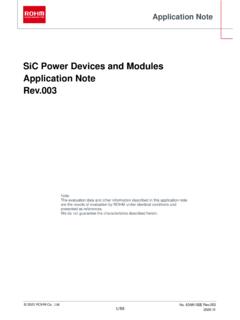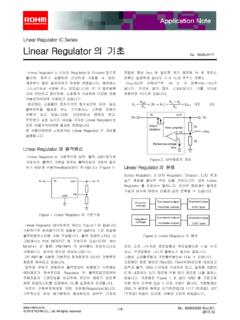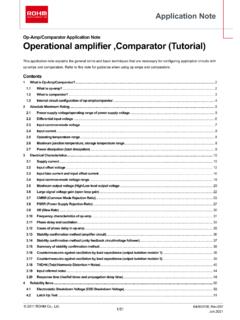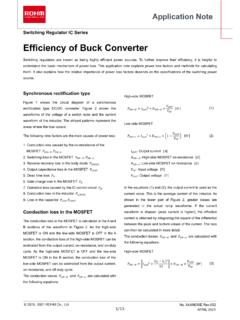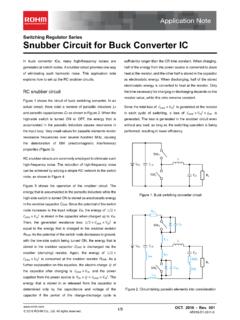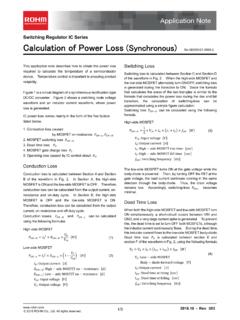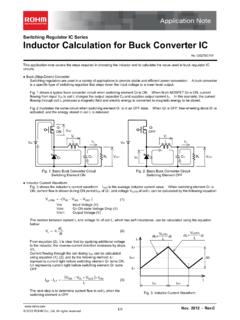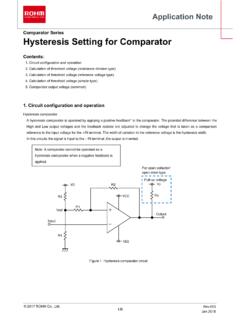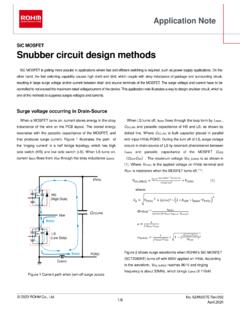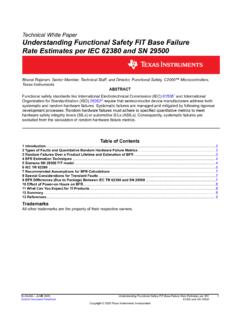Transcription of ISO 26262: Functional Safety Standard for Modern Road …
1 ISO 26262 : Functional Safety Standard for Modern Road Vehicles ISO 26262 Automotive Functional Safety Standard White Paper 1 1. Introduction In recent years, the increasing advancement and proliferation of automated driving have brought about a need for standards such as ISO 26262 that defines Functional Safety along with functions that contribute to the prevention of accidents in the event of an emergency. Especially in China, where the level of technical innovation is considerable, ISO 26262 has been enacted as a recommended national Standard (with a prefix of GB/T ). A Chinese translation of the 1st Edition of ISO 26262 was published in October 2017 as GB/T 34590, before going into effect in May 2018.
2 Amid this backdrop, a growing number of companies are promoting Functional Safety not only among automotive manufacturers (OEMs), but Tier 1 electronics equipment suppliers as well, making it an increasingly important requirement worldwide. In this paper, as interest in Functional Safety and ISO 26262 grows and initiatives and responses are needed, we will introduce these concepts from a semiconductor manufacturer s perspective, including how they affect the automotive sector. 2. What is Functional Safety ? First, let s consider the meaning of Functional Safety . 2-1. The definition of Safe If suddenly asked what the meaning of safe is, most people would have a hard time answering right away. In the 1st edition of the international basic Safety Standard ISO/IEC Guide 51 (which is an introductory guideline on Safety ), the word safe is defined as having no unacceptable risk.
3 This double negative may be difficult to immediately grasp, so perhaps saying, freedom from risk which is not tolerable is easier to understand. However, in any case it is not easy to define safe in one sentence, so let's go over the definition again. The opposite of safe is dangerous . So, what is dangerous ? Dangerous conditions can be referred to as ones that are at risk . In general, risk can be large or small. Therefore, by taking measures against large risk that is dangerous and reducing it to an acceptable range, this dangerous state then becomes a safe state. Or to put it another way, a state without an unacceptably large risk . So now we see that safe=no unacceptable risk as mentioned in the beginning.
4 2-2. Comparison between intrinsic Safety and Functional Safety Now, let s go over the meaning of Functional Safety . The phrase intrinsic Safety is often cited when describing Functional Safety . Here we would like to explain Functional Safety by comparing it to intrinsic Safety . intrinsic Safety is a method for ensuring Safety by removing the causes of danger. Functional Safety , on the other hand, is a method of reducing risks to an acceptable level to ensure Safety by devising functions. As an example, let's consider what measures to take to prevent a train and car from colliding when a road and railway intersect. Achieving intrinsic Safety involves eliminating the inherent dangers of intersecting railways and roads by using overhead crossings to avoid accidents altogether.
5 In accordance with this concept, an overhead crossing physically prevents collisions between cars and trains. ISO 26262 Automotive Functional Safety Standard White Paper 2 In contrast, Functional Safety considers methods such as establishing a railway crossing to reduce the likelihood of a collision. It entails installing a barrier and alarm at the intersection of the railway and road and mounting a sensor on the railway, then sounding the alarm and lowering the barrier when an approaching train is detected. Another sensor is used to detect that the train has passed, after which the alarm is stopped and the barrier is raised. Although in this method railways and roads still physically intersect, railroad crossings are installed to reduce the risk of collisions to an acceptable level.
6 This embodies the concept of Functional Safety . Figure 1. Concepts of intrinsic and Functional Safety As in the previous example, intrinsic Safety guarantees absolute Safety , but generally tends to be very expensive. Although Functional Safety can often be achieved at a lower cost, when designing it is necessary to consider how to ensure Safety when additional functions fail. In the above example of Functional Safety , if the sensor is broken neither the alarm nor barrier will operate when a train approaches. And because this poses an immediate danger, a design mechanism is required that prevents this dangerous condition from occurring if the sensor fails. For example, by attaching a self-diagnostic circuit to the sensor that automatically lowers the barrier if the sensor breaks.
7 This type of design, in which the direction moves towards Safety in the event of failure, is referred to as fail-safe. Alternatively, implementing a redundant design by adding a second sensor that acts when the first sensor breaks (and operates until the broken sensor can be repaired), is often used. Other examples of redundancy include using multiple red lamps in railroad crossing alarms and head/tail lights on cars. These are duplicated not only for design reasons, but also to ensure a minimum level of Safety even if one lamp goes out. 2-3 Achieving Functional Safety The concept of Functional Safety has emerged because it is necessary to make things based on the premise that people make mistakes and things break in order to avoid serious accidents.
8 To achieve Functional Safety , designers need to consider both systematic failure and random failure to prevent harm from being caused by the movement or actions of the object in question. Systematic failures are failures created during design, commonly referred to as bugs. To prevent systematic failures, it is necessary to construct a design flow that does not cause design errors. Specifically, it starts with the creation of specifications based on requirements, ISO 26262 Automotive Functional Safety Standard White Paper 3 and each process including design, verification , prototyping, and evaluation are clarified, with reviews performed at each stage.
9 It is also necessary to manage the documents created at each stage and be able to refer to and retrieve them at any time. In contrast, random failures are failures that occur after manufacturing. Since random failures cannot be completely prevented, a Safety mechanism must be in place to prevent harm even if failure occurs. 2-4 Functional Safety with semiconductors As technological innovations progress, primarily in the automotive and industrial equipment sectors, and electronic systems become more sophisticated and complex, the role of semiconductors increases and Functional Safety measures for semiconductors are required. Semiconductor products typically consist of circuits formed on a silicon substrate, enveloped by a hardened black resin called a mold that protects the circuit but also prevents the interior from being seen.
10 As many as hundreds of thousands or even millions of semiconductor elements such as transistors and resistors can be encapsulated in the mold resin, making the circuit and block configurations quite complex Therefore, in order to handle failures in semiconductor products, it is necessary to introduce an appropriate concept of Functional Safety from the specification stage before entering the design phase. As such, semiconductors need to respond to Functional Safety by considering both systematic and random failures. 3. ISO 26262 and Related Standards Now that we understand the concept of Functional Safety , let us give an overview of the Functional Safety Standard ISO 26262 . Also, keep in mind that there are numerous other Functional Safety standards not limited to the automotive field.
